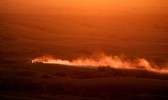This report aired on Sept. 10, 2013 on Prairie Public. It’s part two of a four-part series on injuries and deaths in North Dakota’s oil patch. Todd Melby was the reporter. Photo by Ben Garvin.
Made possible by a grant from the Fund for Investigative Journalism.
I spent Williston and wandering around the oil patch, talking with residents, newcomers and workers. We talked about all sorts of things. But when I spoke with workers, one subject kept popping up.
(Montage of worker voices: “You gotta be careful out there. A lot of people can get hurt over stupid stuff, not paying attention.”/“You never want to be the guy who turns down work or who doesn’t do something. It’s also that kind of attitude that makes things dangerous sometimes, right?”/“I had back surgery when I was 21. I crushed my arm in ’96 and they was going to cut my left arm off. But I still got it.”/”I know that I’ve seen people doing jobs without the right safety gear.”/“Everything out here has potential to seriously hurt you or a lot worse.”)
A lot worse is right.
Government accounts of fatal accidents make for grim reading. There are reports of men falling to their deaths, suffering deadly burns, getting struck in the head with giant pipes and crushed between forklifts and trucks.
As drilling peaked last year, so did oil field deaths.
“We’ve seen a dramatic increase in the number of fatalities largely due to the dramatic increase in the oil and gas work,” says Eric Brooks, local director of the Occupational Safety and Health Administration (OSHA). That’s the federal agency responsible for workplace safety.
Last year in North Dakota, 14 people died while working in the oil fields. So far this year, another nine workers have been killed. That’s 23 dead oil workers in two years. That loss of human life recently has brought North Dakota unwelcome notoriety. In its rankings of the most dangerous places to work in America, the AFL-CIO labor union listed the state as number one at 12.4 deaths per 100,000 workers.
That’s higher than another big oil-producing state — Alaska — which in recent years had topped North Dakota in the rankings.
“You have a lot of new workers, a lot of new workers, a lot of young workers that are associated with the accidents,” says Brooks. “We have found training and communications violations, not universally, but consistently, among the accidents.”
The deaths have prompted OSHA to ramp up training efforts. In February, the agency sponsored a “Stand Down for Safety” meeting for oil companies doing work in the Bakken. Greg Baxter is regional administrator of OSHA. He spoke at the event. “My folks in Washington are essentially asking me, ‘What’s going on? How can you have that many fatalities?’” Baxter says.
One of the things going on is that as the boom rolled through Williston, Watford City, Stanley and other towns in the west, OSHA’s Bismarck office failed to keep pace. In 2008 and 2009 — before the boom really got under way, OSHA had a team of seven senior investigators working in Bismarck. But as drilling rigs flooded the west with new workers and dangerous equipment, OSHA’s North Dakota staff became smaller and less experienced.
In 2010, it had six senior investigators. A year later, its staff shrunk to five. By 2012, the office again had a staff of seven — just like in the pre-boom year of 2008. But with a difference. Instead of seven senior investigators, it employed just one. The other six staffers had a lot less experience. And three were trainees.
“For those particular years when it was quote-unquote lean, we were bringing in additional compliance officers to help us conduct inspections,” Brooks says.
Brooks downplays the importance of on-the-job experience. He says an inspector’s knowledge of a particular industry is more important. So I asked him: how many of the inspectors working in Bismarck have oil and gas expertise.
“Now? All of them,” Brooks says. “All of them have been through well training and are actually card-carrying well control compliance officers.”
“How about 2011?” I ask.
“2011?” Brooks says. “You’re asking me to think here. Depending on what time you’re talking in 2011, it could have been three or four.”
That’s a problem, says Bill Kojola. He’s a health and safety expert at the AFL-CIO. “It’s absolutely crucial that inspectors understand the industry so that they have a very good sense of what the hazards are,” Kojola says. One of Kojola’s jobs at the union is to work on its annual job safety report titled, “Death on the Job.” It’s filled with all sorts of statistical analysis, including the number of years it would take OSHA to conduct surprise inspections at every U.S. workplace. According to the report, it would take OSHA 93 years to visit every work site in North Dakota.
“It’s really ridiculous when you think about it. An employer can say what are my chances of getting a random inspection by OSHA? Well, the chances are slim, very slim,” says Kojola.
Last year, North Dakota made just 25 impromptu visits at oil industry work sites. This year, it ramped up inspections. In April, Eric Brooks ordered his inspectors to roam the western plains. “The nature of this inspection was, our guys are out in the field, if you see a rig, you’re stopping,” he says. In one month, the group made 56 inspections — double the number for all of last year.
Perhaps the state’s OSHA office is beginning to take to heart the words of its regional boss, Greg Baxter. “We got to get mad as hell and we got to stop this,” he says.
More stories from the series are here:
















